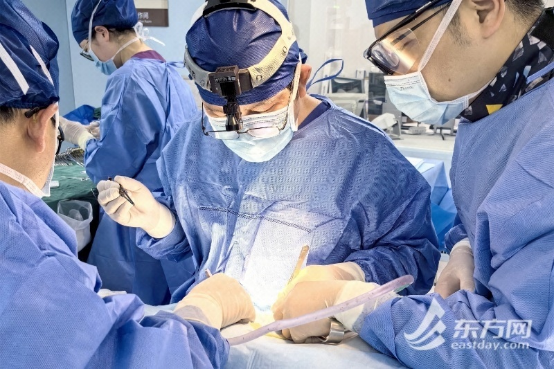- News
The Vascular Surgery Team from Shanghai General Hospital Cleverly Performed "Hybridization" Surgery to Remove Four Types of Vascular Malformations of A Young Man
https://j.021east.com/p/1709688835046959
A young patient was diagnosed with a dangerous "thoracoabdominal aortic dissection" due to chest pain, and further examination discovered four types of aortic arch deformities in his blood vessels simultaneously, like an "untimely bomb" with disordered leads. Facing this dilemma, the team led by Meng Qingyou, Director of the Vascular Surgery Department of Shanghai General Hospital, with the assistance of the Anesthesiology Department and the nursing team, successfully completed the surgery for the patient in the hybrid operating room for 7 hours. The life was saved.

The patient Xiao Zhang comes out of Shanghai who suddenly experienced chest pain during a family dinner and was diagnosed with "thoracic abdominal aortic dissection combined with aortic arch deformity" at a local hospital, making treatment extremely difficult. After multiple consultations, Xiao Zhang came to Shanghai General Hospital for treatment.
After receiving Xiao Zhang, the team led by Dr. Meng Qingyou, the director of the Vascular Surgery Department (North) of the hospital, conducted an aortic CTA examination for him. The examination results show that Xiaozhang's diagnosis of thoracoabdominal aortic dissection is clear, with high blood pressure, fast heart rate, and a risk of rupture at any time. What's even more tricky is that Xiao Zhang has combined four types of aortic arch deformities simultaneously: right aortic arch, vagus right subclavian, vagus left subclavian, and bilateral common carotid artery ectopia.
The aortic arch of a normal person is located to the left after it originates from the heart, and it sequentially emits three arteries: the brachiocephalic trunk (shared by the right common clavicle and right subclavian artery), the left common carotid artery, and the left subclavian artery, commonly known as the "three hairs". And Xiaozhang has "four hairs" congenital: the right subclavian artery directly originates from the aortic arch, and the aorta deviates to the right after originating from the heart. In addition, the order in which the "four hairs" are emitted has also been disrupted, sending out the left common carotid artery, right common carotid artery, right subclavian artery, and left subclavian artery in sequence.
"The situation at that time was very dangerous. Thoracic and abdominal aortic dissection was originally like an untimely bomb, and if surgery was not performed, it could be fatal at any time." Meng Qingyou recalled, "And the patient also had four types of aortic arch deformities at the same time, like the lead of this bomb being completely disrupted, making the surgery even more difficult."
After a quick discussion, the expert team decided to firstly control Xiaozhang's blood pressure and heart rate, improve various examinations, and conduct "hybrid surgery" two days later. Hybrid surgery costs less than minimally invasive surgery and has less trauma than open surgery. It can ensure surgical results while accelerating postoperative recovery and helping patients recover to normal life as soon as possible.
Compared to traditional surgical methods, hybrid surgery has higher requirements from medical teams, and various vascular malformations add a lot of difficulties to the surgery: both subclavian arteries of Xiaozhang require intervention, the left lower limb artery cannot be catheterized due to compression of the dissected true lumen, and the right lower limb artery needs to be operated during surgery. How can arterial catheterization be performed during surgery to monitor real-time blood pressure? The right iliac artery suitable for puncture by Xiao Zhang has been invaded by a dissection. How to select the true lumen and ensure that the dissection does not rupture when placing the sheath tube? The expert team had multiple disciplines discussions and developed detailed contingency plans for each key step of the surgery.
During the surgery, the main surgical team overcame each difficulty with exquisite skills and tacit cooperation. The anesthesia team monitored the entire process to ensure that the patient's blood pressure and heart rate remained stable during the surgery. After more than 7 hours of hard work, the surgery was successfully completed. After taking off over 30 pounds of radiation resistant lead medical clothing, all the doctors' clothes were soaked in sweat. And the postoperative critical care team take over to closely monitoring his vital signs. On the day after the surgery, Xiao Zhang was successfully removed the tracheal intubation and all indicators remained stable, and was transferred to a regular ward. The postoperative follow-up CTA showed good isolation effect of the aortic stent, and the two bridging vessels were unobstructed. As of the time of publication, the patient has successfully recovered and been discharged.
